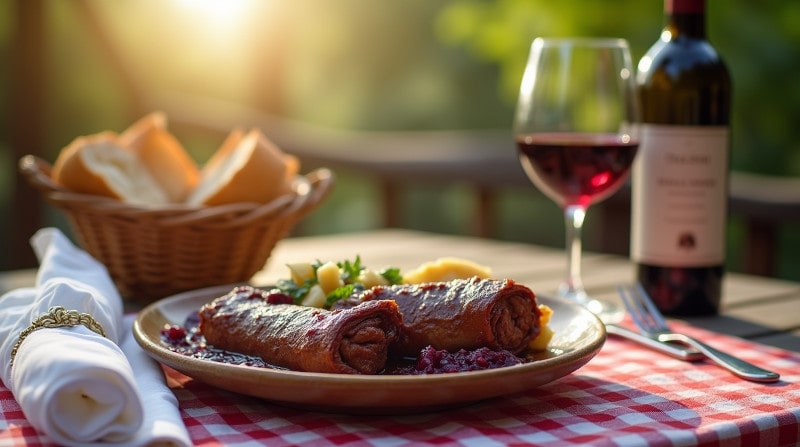A classic braised dish with perfect wine pairing
These braised beef roulades are a true classic of savoury cuisine. The combination of tender braised beef, a spicy filling of bacon, gherkins and mustard and a deeply aromatic red wine sauce ensures a full-bodied flavour experience. The dish gains intensity and depth through its slow preparation, which requires an equally powerful and characterful wine accompaniment. The perfect choice: a spicy, fruity Blaufränkisch, whose tannins and animating acidity wonderfully complement the fullness of the dish.
Why do the following wines go perfectly with this meal?
Blaufränkisch is the ideal accompaniment to braised beef roulades because its spicy fruit, lively acidity and velvety tannins harmonise perfectly with the hearty filling and rich red wine sauce. The acidity of the wine underlines the savoury filling of bacon and mustard, while the dark fruit flavours – often with notes of blackberry, cherry and black pepper – blend wonderfully with the beef and the deep red wine sauce. Its fine tannins also provide a supple structure that emphasises the juiciness of the meat without overpowering it.
Alternatively, other red wines with strong fruit, fine acidity and soft tannins that emphasise the flavour of the roulades without overpowering them are also suitable.
Another 5 wine recommendations for this pairing
1. syrah from the northern Rhône (France)
Syrah from regions such as Cornas or Côte-Rôtie impresses with dark fruit, peppery notes and fine acidity. This combination goes perfectly with the beef roulades, as the spicy flavours complement the filling and the fine acidity harmoniously balances the dish.
2. Cabernet Franc von der Loire (Frankreich)
With its green, herbal notes, red berry flavours and animating acidity, Cabernet Franc is an elegant accompaniment to stews. Its structure and freshness provide an exciting contrast to the savoury sauce and the roasted flavours of the meat. Search for the following designations of origin on the label: Chinon AOC, Saumur-Champigny AOC, Bourgueil AOC, Saint-Nicolas-de-Bourgueil AOC, Anjou AOC
3. tempranillo from Rioja (Spain)
A classic Reserva or Gran Reserva from Rioja brings spicy oak barrel aromas, dark fruit and a silky structure that harmonise perfectly with the depth of the red wine sauce and the savoury notes of the filling.
4. zinfandel from California (USA)
With its lush fruit, soft tannins and fine spice, Zinfandel complements the flavours of the roulades perfectly. Its slight sweetness balances out the savoury filling, while its dark fruit flavours go wonderfully with the sauce.
5. sangiovese from Tuscany (Italy)
A Chianti Classico or Brunello di Montalcino offers red berry fruit, lively acidity and herbal notes that complement both the beef roulades and the deep flavours of the red wine sauce wonderfully.
The recipe:
Braised beef roulades with bacon, gherkins & red wine sauce
Cooking utensils
- 1 Cutting board & knife
- 1 Meat tenderizer
- 1 Large frying pan or casserole
- 1 Cooking spoon & whisk
- 1 Braiser with lid
Ingredients
For the beef roulades:
- 2 Large beef roulades approx. 180 g each
- 2 teaspoon spicy mustard
- 2 Slices of bacon
- 2 Gherkins cut lengthwise into strips
- Salt & pepper to taste
- 1 Tbsp clarified butter for frying
For the red wine sauce:
- 1 Onion finely diced
- 1 Carrot cut into small cubes
- 1 tablespoon tomato paste
- 250 ml Red wine
- 250 ml Beef stock
- 1 Bay leaf
- 1 teaspoon cornflour optional, for thickening
Preparation
Prepare & fill the beef roulades:
- Lay the beef roulades out flat and carefully flatten with a meat mallet.
- Season with salt and pepper and spread with mustard.
- Top each with a slice of bacon and strips of gherkin, then roll up tightly and secure with kitchen string or toothpicks.
Fry & braise the roulades:
- Heat the clarified butter in a casserole and sear the roulades all over.
- Remove, then sauté the onions and carrots in the roasting juices.
- Stir in the tomato purée, fry briefly, then deglaze with red wine.
- Add the beef stock and bay leaf and return the roulades to the pan.
- Cover and simmer over a low heat for approx. 1.5-2 hours until the meat is tender.
Refine the sauce & serve:
- Remove the roulades and keep warm.
- Pass the sauce through a sieve and thicken slightly with cornflour if desired.
- Season to taste with salt and pepper and serve the roulades in the sauce.
Recommended side dishes
- Mashed potatoes with nutmeg
- Red cabbage with apple pieces
- Homemade spaetzle

